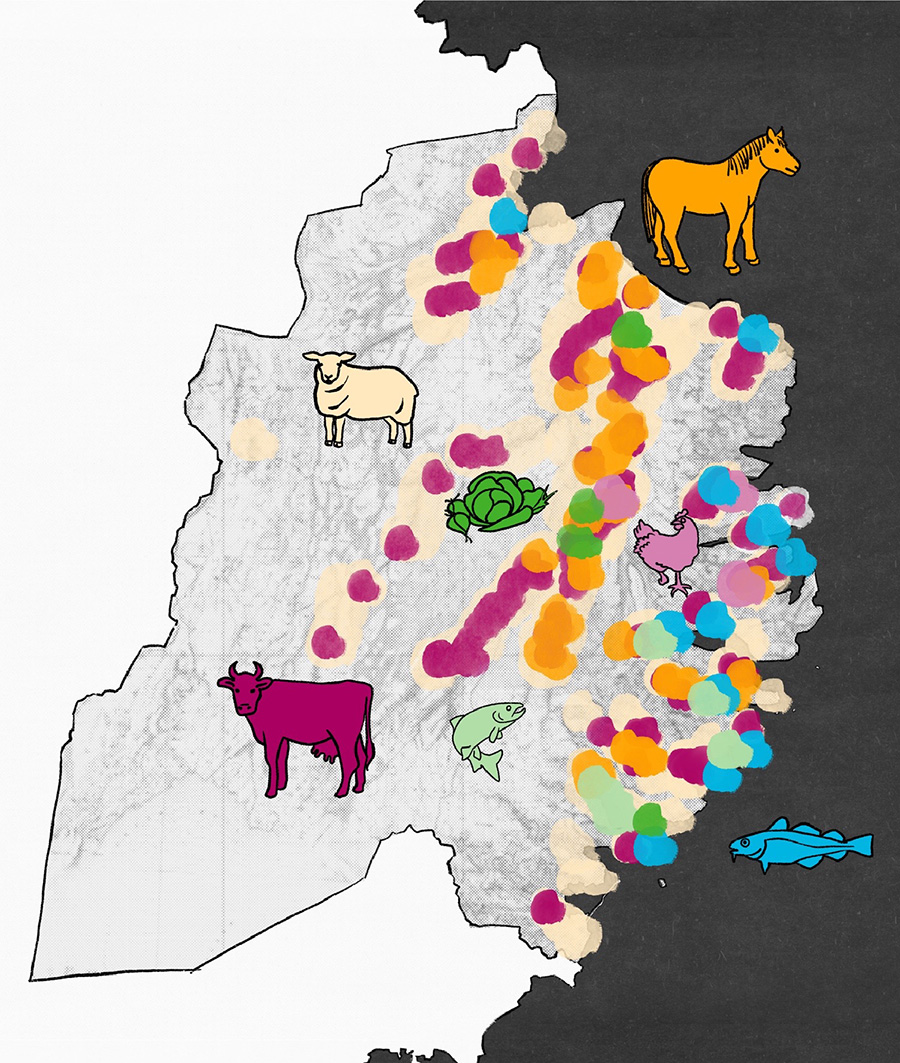4.2 Food Production
In East Iceland, food production in the region will be supported, knowledge will be enhanced, the full processing of raw materials will be increased, and access to East Icelandic food will be improved. The guiding principles are sustainability, value creation, and minimizing waste within the food system. This way, we enhance the quality and image of East Icelandic food and ensure the continued competitiveness of East Iceland as a food production area.

Í.1. Cultivation and harvesting of raw materials for food production should be characterized by respect for resources, and sustainable and responsible use of them.
Utilization of raw materials from the sea, water, and land should be based on knowledge of the respective ecosystems and active monitoring of their condition.
Í.2 Fish farming and harvesting of both traditional and new marine raw materials should strengthen the food production of East Iceland and its related industries.
Research on the potential for utilizing new species for human consumption should be promoted.
Fish farming should be confined to fjords that are already populated and where industrial activity already takes place. Uninhabited fjords should be closed to fish farming, preserving the uniqueness of untouched nature.
Organic fish farming with appropriate certification should be encouraged, and the best technology should be used to mitigate the negative impacts of fish farming on the marine ecosystem.
Emphasis should be placed on research, monitoring, responsible management, and efficient supervision characterizing fish farming in the Eastfjords to ensure product quality and prevent negative impacts on the marine ecosystem.
Efforts should be made to ensure that jobs related to production, processing, supervision, and research are carried out in the region, thereby generating value added in East Iceland.
Efforts should be made for municipalities to receive a share of public revenue from fish farming.
Coastal and general planning should be used to harmonize land use and interests at the boundaries of land and coastal areas.
Í.3 High-quality livestock and vegetable cultivation should be promoted to increase full processing.
Organic agricultural production and its certification should be encouraged.
Opportunities for finding geothermal energy that could be used for food production should be explored.
Technology should be used to increase productivity in agriculture in a sustainable manner.

Í.4 Increased Processing and Full Processing of Raw Materials and Value Creation
Collaboration in product development and innovation in food production should be encouraged among:
- Educational institutions and food producers
- Producers of different foods
- Food producers and companies in other industries
This aims to achieve greater innovation, synergy effects, and competitiveness.
The uniqueness of East Icelandic food should be enhanced, emphasizing healthiness, freshness, and simplicity, along with highlighting seasonal variations.
Í.5 Reducing Food Waste and Increasing Its Use as Raw Material for New Products
Reducing food waste in production, processing, and consumption through awareness and education should be encouraged.
Efforts should be made to improve opportunities for composting food waste.
The development of energy production from waste generated in food production, processing, and consumption should be encouraged.
Other utilization possibilities for waste generated in the food system should be identified.

Explanations on Policy for Food Production and Value Creation
Future Development and Food Policy of Iceland
Globally, the demand for food will increase and change as the population grows and consumption patterns change. New and better ways to ensure food security, increase productivity, and reduce the negative impacts of food production need to be found.
In 2020, the Icelandic government published a food policy for Iceland, aiming to ensure food security in Iceland and strengthen food production across the country. This policy focuses on several key factors: value creation, consumers, appearance and safety, environment, and public health. The goal is to enhance the competitiveness of Icelandic companies with sustainable resource utilization and innovation as guiding principles. The regional planning objectives take these factors into account.
Food Production in East Iceland
In East Iceland, food production from land and sea raw materials is a cornerstone of the economy. Fishing has always been an economic backbone of the communities, and recently, fish farming has been developing in the Eastfjords. However, sea farming pens are typically outside municipal boundaries and thus within the state’s jurisdiction. Nevertheless, fish farming can have direct employment-related impacts by creating jobs, including technical positions requiring university education in farming and production management, as well as related jobs in transportation, contracting, port operations, and net making. The revenue municipalities receive from fish farming includes port fees, property taxes, and local taxes.
Coastal planning is being developed in the Eastfjords24 for future utilization and protection of coastal areas25 from the municipal boundaries to the baseline defined by law on fishing within Iceland’s territorial waters. The planning is shaped by a regional council appointed by the minister, which includes representatives from the state and municipalities.26
Fjarðabyggð, where a significant portion of the region’s fish farming is located, has adopted a fish farming policy emphasizing sustainable farming, fjord carrying capacity determining the extent of farming in each area, and a regulatory framework with effective supervision to minimize potential negative impacts. It also calls for uninhabited fjords to be closed to fish farming, preserving the uniqueness of untouched nature. This protects valuable areas and reduces potential displacement effects of fish farming on other activities, such as tourism27
The national planning policy emphasizes an ecosystem-based approach to coastal planning. This approach involves making resource use decisions based on the best scientific knowledge of the ecosystem and active monitoring of its condition.28

Policy on Distribution, Procurement, and Consumption of Food
J.1 Transportation of East Icelandic Food Within and Outside the Region should be facilitated
The road network should support efficient transportation of food.
Appropriate facilities for cargo transportation should be ensured at Egilsstaðir Airport and the region’s ports.
Efforts should be made to strengthen the possibilities of connecting food transportation by air and sea.
J.2 Strengthening Connections Between Producers, Retailers, and Consumers
Cooperation between regional producers and retailers should be encouraged to best meet market needs.
Increased access to East Icelandic food in stores and restaurants in East Iceland and other regions should be promoted.
Cooperation between producers, restaurants, and tourism providers should be encouraged to create memorable food experiences in East Iceland.
Institutions and companies in East Iceland should be encouraged to buy food and raw materials from the region.
The establishment of an online store selling East Icelandic food with a focus on traceable origin should be encouraged.
Marketing of East Icelandic food abroad should be encouraged.

Explanations on Policy for Distribution, Procurement, and Consumption of Food
Most Icelandic agricultural products are sold domestically, while the opposite is true for seafood and fish farming products. Thus, the demands of foreign markets have influenced the management and processing of seafood, particularly regarding sustainable resource use and product traceability.
The main markets for fish farming, like the fishing industry, are abroad. Fish farming and related activities offer many opportunities and it is important that the industry develops in harmony with the community and connects with the general economy and the region’s knowledge institutions.
